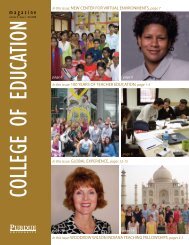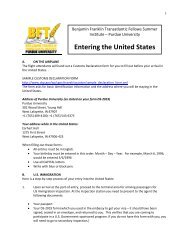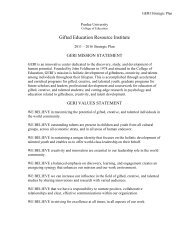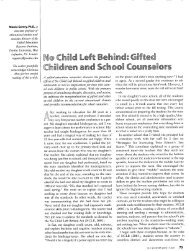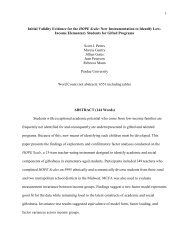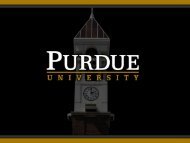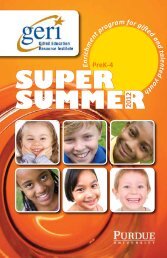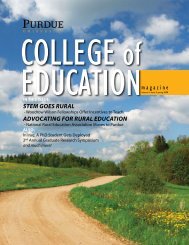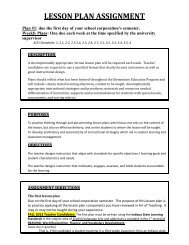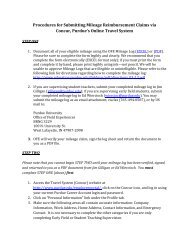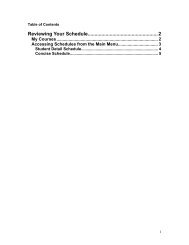StATS: A model of collaboration to develop science talent among ...
StATS: A model of collaboration to develop science talent among ...
StATS: A model of collaboration to develop science talent among ...
Create successful ePaper yourself
Turn your PDF publications into a flip-book with our unique Google optimized e-Paper software.
This article was downloaded by: [Purdue University]On: 11 July 2012, At: 12:07Publisher: RoutledgeInforma Ltd Registered in England and Wales Registered Number: 1072954 Registered <strong>of</strong>fice: MortimerHouse, 37-41 Mortimer Street, London W1T 3JH, UKRoeper ReviewPublication details, including instructions for authors and subscription information:http://www.tandfonline.com/loi/uror20<strong>StATS</strong>: A <strong>model</strong> <strong>of</strong> <strong>collaboration</strong> <strong>to</strong> <strong>develop</strong><strong>science</strong> <strong>talent</strong> <strong>among</strong> rural studentsMarcia Gentry a & Sharon Ferriss ba Assistant Pr<strong>of</strong>essor in the Educational Foundations Department, Manka<strong>to</strong> StateUniversity, Manka<strong>to</strong>b Curriculum coordina<strong>to</strong>r for Quincy community schools, QuincyVersion <strong>of</strong> record first published: 20 Jan 2010To cite this article: Marcia Gentry & Sharon Ferriss (1999): <strong>StATS</strong>: A <strong>model</strong> <strong>of</strong> <strong>collaboration</strong> <strong>to</strong> <strong>develop</strong> <strong>science</strong> <strong>talent</strong><strong>among</strong> rural students, Roeper Review, 21:4, 316-320To link <strong>to</strong> this article: http://dx.doi.org/10.1080/02783199909553984PLEASE SCROLL DOWN FOR ARTICLEFull terms and conditions <strong>of</strong> use: http://www.tandfonline.com/page/terms-and-conditionsThis article may be used for research, teaching, and private study purposes. Any substantial orsystematic reproduction, redistribution, reselling, loan, sub-licensing, systematic supply, or distributionin any form <strong>to</strong> anyone is expressly forbidden.The publisher does not give any warranty express or implied or make any representation that thecontents will be complete or accurate or up <strong>to</strong> date. The accuracy <strong>of</strong> any instructions, formulae, anddrug doses should be independently verified with primary sources. The publisher shall not be liable forany loss, actions, claims, proceedings, demand, or costs or damages whatsoever or howsoever causedarising directly or indirectly in connection with or arising out <strong>of</strong> the use <strong>of</strong> this material.
PROGRAMSDownloaded by [Purdue University] at 12:07 11 July 2012<strong>StATS</strong>: A Model <strong>of</strong> Collaboration <strong>to</strong> Develop Science TalentAmong Rural StudentsMarcia GentrySharon FerrissThis article describes an environmental <strong>science</strong>program for <strong>talent</strong>ed, rural, middleschool students including the background,rationale, and the <strong>collaboration</strong> that made theprogram possible. Descriptive researchresults related <strong>to</strong> the effects <strong>of</strong> this programon student involvement, follow-up, and product<strong>develop</strong>ment over eight program years arereported.Marcia Gentry is Assistant Pr<strong>of</strong>essor in theEducational Foundations Department atManka<strong>to</strong> State University where she teachescourses in research, evaluation, and giftededucation. She also co-directs a new Master'sdegree in gifted education and <strong>talent</strong> <strong>develop</strong>mentthat interfaces gifted education with generaleducation. Sharon Ferriss is a <strong>StATS</strong>facilita<strong>to</strong>r and has <strong>develop</strong>ed the program duringits tenure. She is the curriculum coordina<strong>to</strong>rfor Quincy community schools where previouslyshe taught middle school <strong>science</strong> andwas Michigan's Science teacher <strong>of</strong> the year.Studies for Academically TalentedStudents (<strong>StATS</strong> I) is a program<strong>develop</strong>ed for rural, middle schoolstudents who demonstrate both <strong>talent</strong>and interest in environmental <strong>science</strong>.The major focus <strong>of</strong> the <strong>StATS</strong> I programis <strong>to</strong> <strong>develop</strong> research skills throughindependent and small group investigations(Renzulli, 1977) while increasingenvironmental awareness and the beliefthat one can make a difference andaffect change. Since its inception in1990, <strong>StATS</strong> I has enrolled approximately26 students annually from threerural schools in a year long, regularlyscheduled program. <strong>StATS</strong> I was originallyfunded through the EisenhowerExemplary Program competitivemath/<strong>science</strong> grants in 1990 and in1991. These funds were used <strong>to</strong> purchaselab equipment, computers, andresources <strong>to</strong> sustain the program in subsequentyears. Due <strong>to</strong> the popularity <strong>of</strong>the program and the students' demandfor follow-up, a second phase <strong>to</strong> the programwas <strong>develop</strong>ed that allows students316/Roeper Review, Vol. 21, No. 4<strong>to</strong> continue their studies with the support<strong>of</strong> the <strong>StATS</strong> I facilita<strong>to</strong>rs. <strong>StATS</strong> II wasinitiated in 1991 and includes three components:an agri-environmental wildernessexpedition (AEWE), independentstudy/men<strong>to</strong>ring, and home-school supportservices.Program Background<strong>StATS</strong> is the result <strong>of</strong> <strong>collaboration</strong><strong>among</strong> three rural districts in southernMichigan which have used theirresources and provided in-kind support<strong>to</strong> make this program available <strong>to</strong> theirstudents. Each spring, students are invited<strong>to</strong> apply for admission <strong>to</strong> the <strong>StATS</strong> Iprogram for the following school year.There is a parent/student meeting forthose interested in the program, duringwhich the application procedures andprogram are described and questionsanswered. Students must complete anapplication in which they describe theirinterest in the program, write an essayon an environmental issue <strong>of</strong> theirchoice, and obtain two letters <strong>of</strong> referencedocumenting their interest, commitment,and achievement in <strong>science</strong>.Applications are screened and studentswhose applications are exemplary areinterviewed prior <strong>to</strong> final placement. Ateam <strong>of</strong> adults, including both <strong>of</strong> the<strong>StATS</strong> instruc<strong>to</strong>rs and local district representatives,interviews the students andselects 26 candidates for the program.Approximately half <strong>of</strong> the students whocomplete the application process areplaced in the program each year, and awaiting list is <strong>develop</strong>ed for the followingyear.A fter their selection for <strong>StATS</strong> I,xxstudents take home the EnvironmentalInterest-a-Lyzer (Gentry,1990), adapted from Renzulli's Interesta-Lyzer(1977), <strong>to</strong> complete before theprogram begins. This survey was <strong>develop</strong>edspecifically for the <strong>StATS</strong> programand was designed <strong>to</strong> help students identifyand refine their interests and potentialinterests in environmental <strong>science</strong>s.It contains two questions that assess students'awareness concern about severalenvironmental issues, followed by sixopen-ended questions regarding theirconcerns, knowledge, questions, andinvestigative interests about these issues.The survey concludes with two questionsabout the students' current conservationefforts and what efforts they maywant <strong>to</strong> begin. This information is disaggregatedin the areas <strong>of</strong> the student'senvironmental awareness, concerns,knowledge, questions, interests, andconservation efforts. The areas <strong>of</strong> interestvary with each new <strong>StATS</strong> I classresulting in a curriculum that changeseach year <strong>to</strong> meet the needs <strong>of</strong> the studentsand promote interest-based environmentalliteracy.Since 1990, seventh and eighthgraders have pursued theirshared interests and concerns aboutenvironmental issues through <strong>StATS</strong> Iwhich is scheduled for 17 half-day sessionsduring the school day throughoutthe year. Students from the three districtsare bussed (using existing bus service)<strong>to</strong> and from the <strong>StATS</strong> program atthe area vocational center. Students arereleased from their classes and teacherswork with the <strong>StATS</strong> facilita<strong>to</strong>rs <strong>to</strong> compactcurriculum and <strong>to</strong> eliminate extrawork for the students on these days.<strong>StATS</strong> is a team effort, facilitatedby a local <strong>science</strong> teacher and the vocationalcenter's Natural Resources AgriculturalTechnology instruc<strong>to</strong>r. The two,released from their regular duties, work<strong>to</strong>gether <strong>to</strong> <strong>develop</strong> curriculum, connectwith local agencies, and provide opportunitiesfor students <strong>to</strong> <strong>develop</strong> authenticskills in the environmental <strong>science</strong>s.Rationale<strong>StATS</strong> is based upon the principles<strong>of</strong> providing students with challenge,choice, interest, enjoyment, and personalmeaning in their educational experiencesas a means <strong>to</strong> motivate and <strong>to</strong><strong>develop</strong> lifelong learning habits. It alsoaddresses the need <strong>of</strong> students <strong>to</strong> workManuscript submitted March, 1998.Revision accepted September, 1998.
with others who have similar abilitiesand interests (Rogers, 1991; Robinson,1991). Researchers have suggested thatgrouping students according <strong>to</strong> ability orinterest, in class or across classes, isbeneficial in meeting the academicneeds <strong>of</strong> gifted students (Gentry, 1996;Kulik 1992; Parke, 1989; Rogers 1991),a premise upon which the identificationprocedure for the program is based. Asnoted by Spicker, Southern and Davis(1987), this is especially important forstudents from small rural areas whereopportunities and resources might otherwisebe limited. Finally, <strong>StATS</strong> is basedupon the rationale from gifted educationadvocating the use <strong>of</strong> authentic methods,<strong>develop</strong>ment <strong>of</strong> research skills,through the <strong>develop</strong>ment <strong>of</strong> real-worldproducts and services (Renzulli, 1977;Renzulli & Reis, 1985; Renzulli, 1994).In the <strong>StATS</strong> program, as recommendedby Renzulli (1988), many <strong>of</strong> themethodological activities and productsare completed with the help <strong>of</strong> pr<strong>of</strong>essionalsfrom local and regional agenciesso that the students learn first hand frompracticing pr<strong>of</strong>essionals. The ways inwhich challenge, choice, interest, enjoyment,and personal meaning are <strong>develop</strong>edin <strong>StATS</strong> provide the rationale forthe program.Challenge is an integral part <strong>of</strong>gifted education and can helpensure excellence. The methods andprocesses by which challenge can be<strong>of</strong>fered include: presenting high levelcontent, using advanced thinking skills,using advanced and authentic methodologies,<strong>develop</strong>ing products or servicesfor a real audience, and compacting curriculum(Bloom, 1985; Reis et al, 1993;Renzulli, 1994; Schlichter, 1986; Treffinger,1986; US Department <strong>of</strong> Education,1993). Vygotsky (1962) supportedthe notion <strong>of</strong> challenge in his theoryabout the Zone <strong>of</strong> Proximal Developmentin which he asserted that the onlygood instruction is that which proceedsslightly ahead <strong>of</strong> the learning <strong>develop</strong>ment<strong>of</strong> the child. The federal report,National Excellence: A Case for DevelopingAmerica's Talent (US Department<strong>of</strong> Education, 1993), recognized that theregular curriculum is <strong>of</strong>ten not challengingfor students and called for morechallenging curriculum standards andfor providing students with more challenginglearning opportunities. Recentnational studies on curriculum compacting(Reis et al., 1993) and ClassroomPractices (Archambault, et al., 1993)also provided compelling evidenceabout the need for increased levels <strong>of</strong>challenge.Downloaded by [Purdue University] at 12:07 11 July 2012Choice is a powerful motiva<strong>to</strong>r andhas been consistently recommended <strong>to</strong>enhance student learning (Bloom, 1985;Dewey, 1913, 1916; Goodlad, 1984;Holt, 1983; Renzulli & Reis 1985;Shore et al., 1991; Wang & Lindvall,1984). Shore, Cornell, Robinson, andWard (1991), suggested broad curricularchoices for students related <strong>to</strong> inquiry,discovery and problem solving. Renzulli(1977; 1994) advocated that students begiven opportunities <strong>to</strong> choose problems<strong>to</strong> pursue. He suggested that when studentsare grouped <strong>to</strong>gether by commoninterests and focused on the <strong>develop</strong>ment<strong>of</strong> an authentic product or service,students choose the tasks that meet theirstrengths and <strong>talent</strong>s. <strong>StATS</strong> gives studentschoice within educational activities,providing students ownership andcontrol <strong>of</strong> their learning, thus relevanceand achievement may be enhanced.Interest is another powerful motiva<strong>to</strong>rfor students and, when nurtured,can lead <strong>to</strong> personal and educationalaccomplishments. This is not a new educationalconcept. William James (1890)proposed that awakening and nurturingchildren's interests are central <strong>to</strong> learning,and later, Dewey (1913) suggestedthat educa<strong>to</strong>rs need <strong>to</strong> draw out the abilitiesand interests <strong>of</strong> the child. Gruber(1986) argued that the main force in theself-construction <strong>of</strong> the extraordinary isa person's own activities and interests.Educa<strong>to</strong>rs in gifted education havecalled for interest <strong>to</strong> be central in determininga child's educational program(Gallagher, 1985; Maker, 1982; Parke,1989; Passow, 1982; Renzulli, 1978;Ward, 1980). Further, Deci and Ryan(1985) suggested that because peopleenjoy tasks that interest them, studyinginterests can lead <strong>to</strong> an understanding <strong>of</strong>motivation and learning. In a review <strong>of</strong>recent research related <strong>to</strong> the concept <strong>of</strong>interest, Schiefele (1991) discussed therole <strong>of</strong> interest in learning and motivation,pointing out that people naturallyapproach activities that interest them,making interest a directive force. Hesuggested that adapting instruction <strong>to</strong>student interests may have long termpositive motivational effects. Tobias(1994) also investigated the role <strong>of</strong>interest on learning and reported thatinterest has an energizing effect onlearning and leads <strong>to</strong> a deep comprehension<strong>of</strong> subjects.Enjoyment is also instrumental forstudent involvement in the learningprocess (Csikszentmihalyi, 1990;Dewey, 1916; Renzulli, 1994; Schiefele,1991). Phenix (1964) emphasized theimportance <strong>of</strong> appeal <strong>to</strong> the imaginationfor learning <strong>to</strong> occur, however in hislandmark study, Goodlad (1984) reportedthat most classrooms had flat <strong>to</strong>neswith neutral emotion, ambiance, and apaucity <strong>of</strong> praise and guidance, suggestingthe need <strong>to</strong> create a more enjoyableatmosphere conducive <strong>to</strong> learning. Renzulli(1994) proposed that learning ismost effective when children enjoy whatthey are doing, and that creative productiveindividuals perform at optimal levelswhen they are doing what they mostenjoy. Csikszentmihalyi (1990) foundthat <strong>to</strong>pic interest was significantly correlatedwith involvement, enjoyment,concentration and activation.Creating meaningfulness providesopportunities for students<strong>to</strong> explore and <strong>to</strong> pursue <strong>to</strong>pics andproducts through self-directed learningand <strong>to</strong> <strong>develop</strong> personally meaningfulproducts. As <strong>StATS</strong> is selected by studentswho share a common interest, it issimilar <strong>to</strong> an enrichment cluster (Renzulli,1994) because students want <strong>to</strong> bethere and work <strong>to</strong>gether for a commonlyagreed upon purpose. In a recent studyon the effects <strong>of</strong> enrichment clusters onstudent product <strong>develop</strong>ment, Reis,Gentry and Park (1995) found that over90% <strong>of</strong> the students involved in theclusters produced products. Moreover,when a child loves an area <strong>of</strong> study, thenlearning becomes personally meaningful,helping him or her construct knowledge.Therefore, <strong>of</strong>fering opportunitiesfor students <strong>to</strong> conduct individual andsmall group investigations helps <strong>to</strong> providepersonally meaningful educationalexperiences (Renzulli, 1994).ResultsCollaboration, connection, and afocus on student interests has made theprogram strong and contributed <strong>to</strong> itssuccess. The program is popular withstudents year after year (more interestthan spaces, no attrition, and voluntaryhigh level productivity by students).Further, although it affects the schedules<strong>of</strong> three middle schools and pulls studentsout <strong>of</strong> school during regular classtime, it maintains the support <strong>of</strong> personnelfrom those schools. Communicationthrough the students, by facilita<strong>to</strong>rs, andvia projects that connect <strong>to</strong> the homeschools—such as the <strong>StATS</strong> newsletter,surveys, and recycling efforts—havehelped <strong>to</strong> integrate <strong>StATS</strong> with thehome schools. Consequently there havebeen few problems with the program'sacceptance. Further, by using existingpersonnel, resources, busing, and facili-May/June, 1999, Roeper Review/317
Downloaded by [Purdue University] at 12:07 11 July 2012dents attend training sessions prior <strong>to</strong>the week-long backpacking trip. Trainingincludes low impact camping andsafety, pho<strong>to</strong>graphy, journalizing techniques,and field research methods. Duringthe trip, students conduct an interestbasedresearch project and journal theexperience. Upon completion <strong>of</strong> a portfolioproject, they earned 1/2 highschool credit. Since its inception,AEWE has involved 210 students inweek long low-impact camping andfield experiences <strong>to</strong> Isle Royale NationalPark, MI; Porcupine Mountains NationalPark, MI; Smoky Mountains NationalPark, TN; Algonquin Provincial Park,CAN; Boundary Waters WildernessArea, MN; Yellows<strong>to</strong>ne National Park,WY; and White Mountains NationalForest, NH. Students produced a variety<strong>of</strong> products in this program including apho<strong>to</strong> exhibit and community forum, ahiking manual, several newspapercolumns and pho<strong>to</strong> essays, and animpact survey regarding the effects <strong>of</strong>humans on the flora <strong>of</strong> National Parks.Several students involved in AEWEhave expressed interest in pursuingenvironmental-related careers.Independent Study/ Men<strong>to</strong>rshipsIndependent study enables students<strong>to</strong> collaborate with men<strong>to</strong>rs after submittingan acceptable research proposal.For example, in 1995-96 an eleventhgrade student submitted a proposal <strong>to</strong>work with the soil conservation district<strong>to</strong> <strong>develop</strong> a video tape that describedthe wetland res<strong>to</strong>ration project in thecounty. This video was designed as aeducational training tape and was submitted<strong>to</strong> the state <strong>of</strong> Michigan'sDepartment <strong>of</strong> Environmental Qualityas a part <strong>of</strong> a grant awarded <strong>to</strong> the countyfor improving water quality in thecounty. The student worked with fieldagents from the soil conservation district,then wrote, filmed and edited thetape. She sought pr<strong>of</strong>essional narrationand editing assistance through a localmedia specialist who helped her <strong>develop</strong>a pr<strong>of</strong>essional product. As a result <strong>of</strong>this student's work with the soil conservationproject and field agents whoacted as men<strong>to</strong>rs, this tape is now usedstate-wide as an educational <strong>to</strong>ol.Another example <strong>of</strong> a student initiatedindependent study/men<strong>to</strong>rship experienceis that <strong>of</strong> a ninth grade student whosubmitted a research proposal <strong>to</strong> workwith a limnologist from Eastern MichiganUniversity <strong>to</strong> study the effects <strong>of</strong>grazers on algae decomposition <strong>of</strong> cattails.The experimental design was presentedat the Michigan Academy <strong>of</strong> SciencesAnnual Meeting in April <strong>of</strong> 1997.Another student <strong>develop</strong>ed an ideafor an original board game that exploredthe effects <strong>of</strong> calories and cholesterol onhealth. During the next four years, thisstudent <strong>develop</strong>ed the concept, fieldtested a pro<strong>to</strong>type <strong>of</strong> the game, maderevisions and worked with a pr<strong>of</strong>essionalin the graphic arts field <strong>to</strong> lay out anddesign the final version. A US copyrightwas applied for and granted, and the studentis working with a marketing pr<strong>of</strong>essional<strong>to</strong> distribute the game.As part <strong>of</strong> the <strong>StATS</strong> II independentstudy/men<strong>to</strong>rship option,students interested in teaching havewritten and implemented lesson plansfor environmental studies with elementarystudents. An outdoor pond dayexperience initiated by independentstudy students has become part <strong>of</strong> theregular elementary <strong>science</strong> curriculumin one school district. Other studentshave pursued their interest in journalism,and under the supervision <strong>of</strong> theedi<strong>to</strong>r <strong>of</strong> the local newspaper are workingon staff. Their articles are published,and one student has a regular column.Home-School Support ServicesA third way in which the <strong>StATS</strong> Iprogram is extended is through support<strong>of</strong> home school activities for <strong>StATS</strong> students.Program materials are loaned <strong>to</strong>students, instruc<strong>to</strong>rs give additional timefor technical assistance, and small minigrantsare available <strong>to</strong> fund acceptablestudent proposals. This opportunityallows <strong>StATS</strong> students across the county<strong>to</strong> become more involved in advanced<strong>to</strong>pics for <strong>science</strong> fairs, special projects,research, and competitions such as ScienceOlympiad. Additionally, <strong>StATS</strong>products and resources are made available<strong>to</strong> local teachers as a means <strong>of</strong> supportingthe home schools and buildingbridges between the programs.Discussion: Limitations,Implications, and TrendsAlthough the descriptive results <strong>of</strong>this project were impressive, there existseveral limitations <strong>to</strong> the current studyincluding the ex post fac<strong>to</strong> nature <strong>of</strong> thedata; the lack <strong>of</strong> valid/reliable instrumentation;and the generalizibility <strong>of</strong> thisrural program <strong>to</strong> other settings. To providedocumentation <strong>of</strong> the effectivenessin future research or replication studies<strong>of</strong> similar special programs, the authorssuggest planning the research at theonset <strong>of</strong> the program. The <strong>StATS</strong> programs,as with many innovations in education,was not designed as a researchstudy, and only after several years <strong>of</strong>what seemed <strong>to</strong> be successful existencedid those involved consider reportingresults. By planning and collecting dataas programs are <strong>develop</strong>ed, implemented,and carried out, and by employing acombination <strong>of</strong> quantitative and qualitativemethods, more substantive findingsthan those reported here may beachieved. For example, yearly exit interviews,as well as follow-up interviews atscheduled intervals, with students wouldhave provided valuable insight in<strong>to</strong> boththe short-term and long-term effects <strong>of</strong>their involvement in the program.Although the descriptive, ex post fac<strong>to</strong>approach used in this study providedinsight in<strong>to</strong> the programs, their activities,and effects on students, adding a quantitativeapproach would have providedgreater insight. By using pre and postmeasures on variables such as achievement,product quality, self-efficacy, andself-concept, more definitive outcomescould have been measured. Combiningquantitative and qualitative methodswould serve researchers, coordina<strong>to</strong>rs <strong>of</strong>gifted programs, and program <strong>develop</strong>ersby providing a more complete picture<strong>of</strong> the observable and measurable effects<strong>of</strong> such programs when they are implemented.Although the information in thisstudy may not be entirely new<strong>to</strong> the field <strong>of</strong> gifted education, it doesserve <strong>to</strong> illustrate how some strategiescan be integrated and <strong>develop</strong>ed in<strong>to</strong> aprogram that transcends traditionalschool boundaries in a rural setting. Forareas with limited resources and smallpopulations, such cooperative programmingshould be considered as a meansby which resources can be pooled andstudents' special interests and <strong>talent</strong>scan be served. In the absence <strong>of</strong> cooperationand creativity on the part <strong>of</strong> theschool districts and educa<strong>to</strong>rs involved,such programs would not exist. Thisprogram can also serve as a <strong>model</strong> forusing student interests and strengths<strong>to</strong>gether with real-world problems and<strong>collaboration</strong> within educational venuesfrom special programs <strong>to</strong> the "regularclassroom."After eight years, <strong>StATS</strong> continues<strong>to</strong> grow and change in response <strong>to</strong> studentinterests and directions. In a ruralarea with limited resources, this programhas managed <strong>to</strong> <strong>of</strong>fer enrichingeducational experiences <strong>to</strong> students thatwould not be found in their ownschools. The numbers <strong>of</strong> students whoproduce products in <strong>StATS</strong> I (85% andgreater, each year), and the number <strong>of</strong>students who continue their studies afterthe conclusion (35% and greater, eachMay/June, 1999, Roeper Review/319
year) are a indicative <strong>of</strong> the program'ssuccess. In a county with 6000 studentsattending 3 rural school districts, thenumbers <strong>of</strong> students in any one middleschool with a passion for the environmentprobably would not sustain anintensive program such as <strong>StATS</strong>. However,with <strong>collaboration</strong>, these students,bonded by their common interests andstrengths have been able <strong>to</strong> come <strong>to</strong>getherregularly during the school year <strong>to</strong>pursue these interests.<strong>StATS</strong> currently serves as a<strong>model</strong> program for educa<strong>to</strong>rsinterested in <strong>develop</strong>ing similar collaborativeventures that concentrate on areas<strong>of</strong> student interest and <strong>talent</strong> <strong>develop</strong>ment.The facilita<strong>to</strong>rs <strong>of</strong> the <strong>StATS</strong> programhave made presentations about theprogram at regional, state, national andinternational conferences. Chosen as one<strong>of</strong> 35 programs from a national searchfor exemplary environmental programs,<strong>StATS</strong> is highlighted in the EPA'sguide, Getting Started: a Guide <strong>to</strong>Bringing Environmental Education In<strong>to</strong>Your Classroom (Bones, 1994). Additionally,<strong>StATS</strong> demonstrates what ispossible when the learning is authentic,challenging, meaningful, and groundedin student interests. Perhaps an additionalvalue <strong>of</strong> such a program is <strong>to</strong> remindus that students can accomplish greatthings that go well beyond our curriculumand standardized tests, if we onlyprovide them the time and latitude <strong>to</strong>explore their interests, dreams, and passions.As suggested by Renzulli (1994)this is most likely <strong>to</strong> occur when studentswith common interests areDownloaded by [Purdue University] at 12:07 11 July 2012grouped with facilita<strong>to</strong>rs who will helpthem pursue these interests in a rigorous,challenging, authentic manner.REFERENCESArchambault, F. X., Westberg, K., Brown, S. B., Hallmark,B. W., Emmons, C. L., & Zhang, W. (1993). Regularclassroom practices with sifted students: Results <strong>of</strong> anational survey <strong>of</strong> classroom teachers. S<strong>to</strong>rrs, CT: TheNational Research Center on the Gifted and Talented.Bloom, B. S. (Ed.). (1985). Developing <strong>talent</strong> in young people.New York: Ballantine Books.Bones, D. (Ed.). (1994). Getting Started: A Guide <strong>to</strong> BringingEnvironmental Education In<strong>to</strong> Your Classroom.University <strong>of</strong> Michigan: Ann Arbor.Csikszentmihalyi, M. (1990). Literacy and intrinsic motivation.Daedalus, 119, 115-140.Deci, E. L., & Ryan, R. M. (1985). Intrinsic motivation andself-determination in humanDewey, J. (1913). Interest and effort in education. NewYork: Hough<strong>to</strong>n Mifflin.Dewey, J. (1916). Democracy and education. New York:Hough<strong>to</strong>n Mifflin.Gallagher, J. J. (1985). Teaching the gifted child (3rd ed.).Bos<strong>to</strong>n: Allyn & Bacon.Gentry, M. L. (1990). The Environmental Interest-a-Lyzer.Unpublished program instrument. Coldwater, MI:Branch ISD.Gentry, M. L. (1996). Cluster grouping: An investigation <strong>of</strong>student achievement, identification, and classroompractices. Unpublished doc<strong>to</strong>ral dissertation, University<strong>of</strong> Connecticut, S<strong>to</strong>rrs, CT.Goodlad, J. I. (1984). A place called school. New York:McGraw Hill.Gruber, H. E. (1986). The self-construction <strong>of</strong> the extraordinary.In R. J. Sternberg & J. E. Davidson (Eds.), Conceptions<strong>of</strong> giftedness (pp. 247-268). Cambridge, MA:Cambridge University Press.Holt, J. (1983). Escape from childhood. In J. W. Noll (Ed.),Taking sides: Clashing views on controversial educationalissues (2nd ed.) (pp.40-44). Guilford, CT:Dushkin Publishing Group.James, W. (1890). The principles <strong>of</strong> psychology. London:MacMillan.Kulik, J. A. (1992). An analysis <strong>of</strong> the research on abilitygrouping: His<strong>to</strong>rical and contemporary perspectives.S<strong>to</strong>rrs, CT: The National Research Center on the Giftedand Talented.Maker, C. J. (1982). Curriculum <strong>develop</strong>ment for the gifted.Austin, TX: Pro-Ed.Parke, B. (1989). Gifted students in regular classrooms.Bos<strong>to</strong>n: Allyn & Bacon.Passow, A. H. (1982). The relationship between the regularcurriculum and differentiated curricula for the gifted/<strong>talent</strong>ed.In Selected proceedings <strong>of</strong> the first national conferenceon curricula for the gifted/<strong>talent</strong>ed. Ventura,CA: Ventura Superintendent <strong>of</strong> Schools Office.Phenix, P.H. (1964). Realms <strong>of</strong> meaning. New York:McGraw-Hill.Reis, S. M., Gentry, M. L., & Park, S. (1995). Extending thepedagogy <strong>of</strong> gifted education <strong>to</strong> all students: Theenrichment cluster study. S<strong>to</strong>rrs, CT: National ResearchCenter on the Gifted and TalentedReis, S. M., Westberg, K. L., Kulikowich, J., Caillard, F.,Hebrew, T.,, J., Purcell, J. H., Rogers, J. B., & Smist, J.M. (1993). Why not let high ability students start schoolin January? The curriculum compacting study. S<strong>to</strong>rrs,CT: The National Research Center on the Gifted andTalented.Renzulli, J. S. (1977). The enrichment triad <strong>model</strong>. MansfieldCenter, CT: Creative Learning Press.Renzulli, J. S. (1978). What makes giftedness? Reexamininga definition. Phi Delta Kappan, 60(3), 180-184, 261.Renzulli, J. S. (1988). The multiple menu <strong>model</strong> for <strong>develop</strong>ingdifferentiated curriculum for the gifted and <strong>talent</strong>ed.Gifted Child Quarterly, 32, 298-308.Renzulli, J. S. (1994). Schools for <strong>talent</strong> <strong>develop</strong>ment: Acomprehensive plan for <strong>to</strong>tal school improvement.Mansfield Center, CT: Creative Learning Press.Renzulli, J. S., & Reis, S. M. (1985). The schoolwide enrichment<strong>model</strong>: A comprehensive plan for educationalexcellence. Mansfield Center, CT: Creative LearningPress.Robinson, A. (1991). Cooperative learning and the academically<strong>talent</strong>ed student. S<strong>to</strong>rrs, CT: The NationalResearch Center on the Gifted and Talented.Rogers, K. B. (1991). The relationship <strong>of</strong> grouping practices<strong>to</strong> the education <strong>of</strong> the gifted and <strong>talent</strong>ed learner.S<strong>to</strong>rrs, CT: The National Research Center on the Giftedand Talented.Schiefele, U. (1991). Interests, learning and motivation.Educational Psychologist, 26, 299-323.Schlichter, C. (1986). Talents unlimited: Applying the multiple<strong>talent</strong> approach <strong>to</strong> mainstream and gifted programs.In I. S. Renzulli (Ed.), Systems and <strong>model</strong>s for <strong>develop</strong>ingprograms for the gifted and <strong>talent</strong>ed (pp. 352-390).Mansfield Center, CT: Creative Learning Press.Shore, B. M., Cornell, D. G., Robinson, A., & Ward, V. S.(1991). Recommended practices in gifted education.New York: Teachers College Press.Spicker, H. H., Southern, W. T., & Davis, B. (1987). Therural gifted child. Gifted Child Quarterly, 31(4).Tobias, S. (1994). Interest, prior knowledge and learning.Review <strong>of</strong> Educational Research, 64(1), 37-54.Treffinger, D. (1986). Fostering effective independent learningthrough individualized programming. In J. S. Renzulli(Ed.), Systems and <strong>model</strong>s for <strong>develop</strong>ing programsfor the gifted and <strong>talent</strong>ed (pp. 429-460).Mansfield Center, CT: Creative Learning Press.U.S. Department <strong>of</strong> Education, Office <strong>of</strong> EducationalResearch and Improvement. (1993). National excellence:A case for <strong>develop</strong>ing America's <strong>talent</strong>. Washing<strong>to</strong>n,DC: U.S. Government Printing Office.Vygotsky, L. S. (1962). Thought and language. Cambridge,MA: M.I.T. Press.Wang, M. C., & Lindvall, C. M. (1984). Individual differencesin school learning environments: Theory, researchand design. In E. W. Gordon (Ed.), Review <strong>of</strong> researchin education (Vol. 11) (pp. 161-226). Washing<strong>to</strong>n, DC:American Educational Research Association.Ward, V. (1980). Differential education for the gifted. Ventura,CA: Ventura Superintendent <strong>of</strong> Schools Office.Distance education for the gifted and <strong>talent</strong>ed:An interactive design <strong>model</strong>David H. McKinnonC. J. Patrick NolanIn 1994, the New South Wales Board <strong>of</strong> Studies, Australia, introducedthree high level Distinction Courses for gifted and <strong>talent</strong>ed students:comparative literature, cosmology, and philosophy. All are <strong>of</strong>fered bydistance education but the cosmology course employs an interactivedesign <strong>model</strong> and an extensive communication system that differentiatesit from the other two. This article explains the <strong>model</strong> and the way itis used in practice <strong>to</strong> organize, sequence and deliver the course. Discussionaddresses ways in which the <strong>model</strong> might be used <strong>to</strong> design awider range <strong>of</strong> courses for gifted and <strong>talent</strong>ed students.David H. McKinnon is a senior lecturer in the Faculty <strong>of</strong> Education atCharles Sturt University, Bathurst, Australia. He is the Course Coordina<strong>to</strong>r<strong>of</strong> the Cosmology Distinction Course. His main academic andresearch interests are curriculum <strong>develop</strong>ment, education with computers,<strong>science</strong> education and the education <strong>of</strong> the gifted and <strong>talent</strong>ed.C. J. Patrick Nolan is the direc<strong>to</strong>r <strong>of</strong> the Educational Research andDevelopment Center and Associate Pr<strong>of</strong>essor <strong>of</strong> Education at MasseyUniversity, New Zealand. His main academic interests are curriculum<strong>develop</strong>ment, education with computers, experiential learning, andschool <strong>develop</strong>ment and administration.320/Roeper Review, Vol. 21, No. 4



